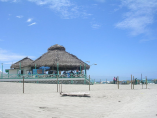Honduras
Central AmericaLevel of surfing
Evolved
Quality of surf
Good
Call code
504
Net code
hn
Area
112492
Coastline
820 km
Climate
Subtropical in lowlands, temperate in mountains
Hazards
Coup / Civil Unrest
Best Months
September - December
Population
7483763
Currency
Lempira (HNL) lempiras per US dollar - 18.895 (2006)
Time Zone
CST (UTC-6)
Special Requirements
Private Beaches
surfing

Alarikoeloko17: El delfin, Tela Beach; 2007
The Caribbean, she is a harsh mistress. All of the islands in the Greater and Lesser Antilles share at least some aspect towards the North Atlantic and therefore are exposed to any passing fronts that generate of the East American Coast and transit the North Atlantic. These fronts often pass a good way to the north and swell decay can be a problem.
Regular windswell is a constant on the east coast of all of the island groups and hence there is almost always something to keep you occupied and off the rum for a few hours. too much wind can be a bad thing though and onshore days are very common, no matter how early in the morning you manage to peel yourself out of your cot and stumble down to the beach.
The third source of swell in the region are from passing hurricanes. Some of the strongest storm ever recorded on the planet file through here regularly. Technically the season spans June to November with early September being the peak. The ideal scenario is for the hurricane mass to pass clear of any inhabited areas and sit well offshore in the deep Carribean for a few days prior to disipating. The result is typically 3-5 days of western swell that lights up the hidden western points and reefs of the Caribbean. The persistant NE/E trade winds will gently fan these breaks all day long. It is then that some of the rarer points and breaks of Honduras come to life. Surf exploration doesent get any better than this. The Pacific coast of Honduras is really only limited to the enclosed gulf of Fonseca, options for El Salvador to the north and Nicaragua to the south but little to offer Honduras.
what to pack

Kkkdc: Electronically regulated, variable output LED flashlight; 5 August 2006
There is a rainy season from May to October (so take an umbrella and pack accordingly) and
a dry season from November to April.The coast is hot all year, so cotton shirts or blouses are best. Make sure you take a good sunscreen
(SPF 30+) and a good insect repellent. Hat and natural fabrics (such as cotton or linen) clothes will be very useful. Light coat or sweater can become handy since some nights are fresher or you might get a bad weather. Raincoat and rubberboots with light, long trousers if you plan bushwalking. Waterproof bag will be great for the rainy season.
You won't regret swimming & snorkelling gear and a quick drying towel! And take films and memory cards with you (can be hard to find and expensive). Little swiss knife and a good torch will be useful. Anti-malaria drugs (Aralen) and all the medicines you use on a daily basis.






